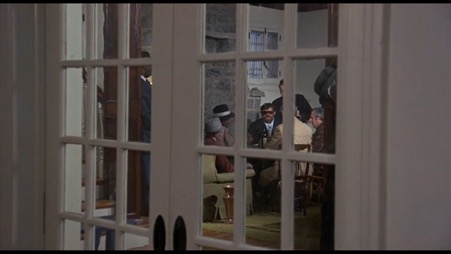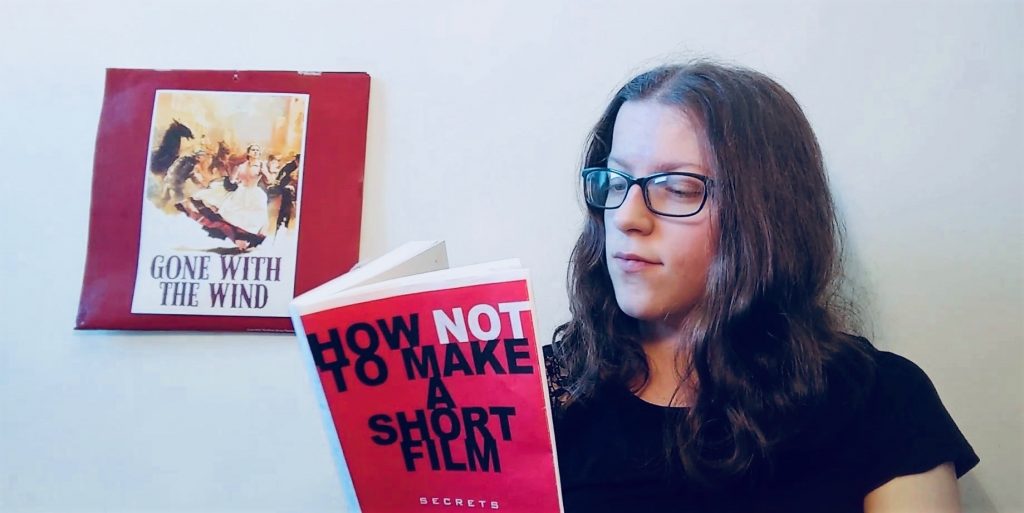The King of Marvin Gardens (1972) was made at a time of significant change and division in the United States, with many marginalized groups such as Native Americans, LGBT people, women, and African Americans becoming increasingly active in their fight for rights, and a conservative ‘New Right’ movement emerging partly in response. One clear manifestation of this conflict was the division between the classes in American society. During the late 1960s and early 1970s the middle classes felt side-lined and unrepresented by political protests orientated around identity and civil rights and by the focus on the alleviation of poverty by President Johnson’s Great Society projects (Schulman). In this sequence, the mise-en-scene is handled in such a way as to make David Staebler (Jack Nicholson), the central character in this scene, almost invisible. The colour in the shot is desaturated; the murky whiteness of the houses is overpowering, and even the small patches of grass and sky are muted to appear more grey than green or blue. Staebler’s brown coat fades into the background; he is visible only through his movement. The high key lighting creates little contrast in the shot – Staebler is not emphasized at all (fig. 1). Staebler’s marginalised position within the frame, and his tangential relation to the disregarded objects that surround him, position him as a man out of place. Staebler appears unwelcome and ignored, arguably emulating a certain middle class-consciousness of the period.

As Staebler walks through the affluent neighbourhood in Atlantic City towards the home of the gangsters his brother Jason wants him to see, the cinematography lends the houses an “air of decay” (Cronin). Patterson points out that ‘the Atlantic City of those years, with its ruined pier and empty hotels, was a crumbling pleasure dome’ (Patterson), and these fading yet ornate houses reflect what, as Le Fanu suggests, can be argued to be a “theatrical façade”. The austere but elaborate architecture is indicative of the class system and its display of wealth and power, a system that demands materialism and spectacle over anything else. This exhibition of affluence diminishes Staebler; and as Samuel states, ‘as the income gap began expanding […] the middle class began shrinking, effectively returning [to a] pre-Depression class hierarchy’ (141). The middle classes felt diminished, pushed to the background by the growing wealth of the prosperous.

Inside the house, the theme continues: Staebler is led in through the back entrance, where whitewashed walls denote an emptiness inside the ornateness, and the partitions of the space encroach on Staebler and obstruct his ability to see and hear. Throughout the sequence the camera remains with Staebler; the viewer, like him, can only parse what is going on with the group of men in the other room through the glass sections of the doors (fig. 2). Camera position, blocking and the location combine to distance Staebler and the viewer from the gangsters in the next room, indicating the distance their wealth and power creates, despite the presumed illegality that underpins their more powerful social position. The wooden framing, too, blocks the view, perhaps a reflection of the prison bars blocking Staebler from his brother Jason in the previous scene, another sense of Staebler’s inability to reach those of, or aiming for, a higher social position than he.

The room Staebler sits in is full of objects that could easily be read as similar to his situation. Closed folding chairs and blinded windows, indicative of a lack of use; a board of blueprints, suggesting unfulfilled plans; mismatched telephones, implying an incompatibility with his situation – all could in some way represent a man side-lined, set aside, no longer consequential. His dark hair, brown suit, white shirt, black trousers, and grey gloves are all as plain as his surroundings, and he once again appears to fade into the space, just one forgotten object among many. The only spots of colour in the frame are the telephones which Staebler rearranges: perhaps there is an implication here of at least some desire to return to a time or situation he deems to be correct, but all he is able to do is rearrange two telephones, nothing more. This presentation of Staebler’s lack of agency reflects his narrative arc in the wider film; he has little desire to facilitate Jason’s wild dreams and he eventually returns home, with his brother’s corpse, a bleak sign of his ineffectuality and readable as a modelling of middle-class impotency.
Unlike Staebler, the gangsters’ room is more colourful, their clothes include red and blue, and the décor around them is far more varied than the monotonous colour palette of Staebler’s anteroom. This spatial separation and colour contrast could extend to a commentary on the racial tensions at the time, as a number of the gangsters are African-American. A consequence of steps towards equality is that those who previously had the monopoly on wealth and social status may feel as if they are being undermined as the oppressed are brought up. By the early 1970s, when the film takes place, the 1964 Civil Rights Act and 1965 Voting Rights Act had been passed, both significant steps in the civil rights movement. It is possible that David not only represents a middle-class fear of exclusion with the rising status of the rich, but also a fear of exclusion amongst white Americans with the rising status of African-Americans – although the former is undoubtedly more rational, both were widely felt.
The mise-en-scene distinguishes Staebler as separate and different in a number of ways and reflects harshly on the difference in social class between him and the gangsters – they are visible, wealthy and powerful, while Staebler sits amongst the browns and greys of the forgotten middle class, fading into the background. However, the “emptiness of American capitalism” (Benshoff and Griffin, 194) and the emptiness of the world Staebler finds himself in, makes it clear that the gangsters’ higher class lives are nothing more than a façade created by a capitalist system that defines success only by flashy extravagance, a system that makes Staebler, and the middle classes, feel almost invisible.
References
Benshoff, Harry and Griffin, Sean. America on Film: Representing Race, Class, Gender, and Sexuality at the Movies. Sussex: Blackwell: 2003. Print.
Cronin, Sarah. ‘The King of Marvin Gardens’. electricsheepmagazine.co.uk. 23 May 2013. Web. 14 Mar. 2018.
Le Fanu, Mark. ‘The King of Marvin Gardens: A Killing’. Criterion.com. 2010. Web. 14 Mar. 2018.
Patterson, John. ‘The King Of Marvin Gardens shows the last gasp of a crumbling America’. theguardian.com. 19 May 2013. Web. 1 May 2018.
Samuel, Lawrence. The American Middle Class: A Cultural History. Oxford: Routledge: 2013. Print.
Schulman, Bruce. The Seventies: The Great Shift in American Culture, Society, and Politics. New York: Simon and Schuster: 2001. Print.
Tonguette, Peter. ‘Alone in the Dark: Bob Rafelson’s The King of Marvin Gardens’. filmcomment.com. 2012. Web. 14 Mar. 2018.

Alex Kelly is a BA Hons student in Film Studies at QMUL. Additionally, she also has a keen interest in history, theatre, and writing, and hopes to become a screenwriter in the future.
Please obtain permission before redistributing. Copyright © 2018 Alex Kelly